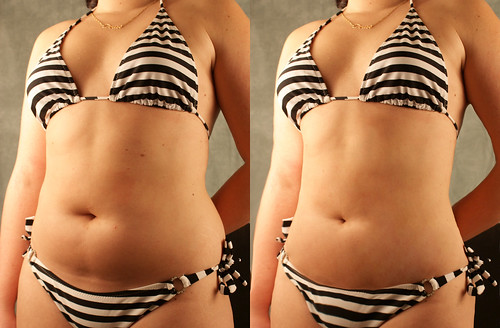I’m an avid supporter of women’s health initiatives. It makes sense: many of my dearest friends, the people I love and adore are women and I want them to enjoy happiness, vivacity and a long active life (that’s one reason I’m trying to kill running). Some may consider this selfish motivation, but if it results in helping the people around me achieve extreme health and longevity, then I’m okay with my lack of altruism: selfishness as virtue, so to speak.
I’m also a big fan of the truth. That’s why the Israeli government piqued my interest by passing a law that makes advertisers and publications clearly display when they’ve digitally altered a model’s photo to make them look thinner. The Israeli government passed the law on Monday, which also requires that models used in advertising fall above the World Health Organization’s (WHO) definition of malnourished*.
(*The WHO uses BMI to define health which is shitty, at best, since it doesn’t accurately predict body fat percentage or health unless you’re 70 or older[1,2] or are composed of more than 35% fat[3]—which means you’re the same molecular consistency as a pork rind and at that point you should be able to figure out you’re not healthy without the aid of a BMI calculation. But I’m not here to complain about preeminent health authorities using a 200-year-old hack to assess an individual’s health.)
The Israeli law is meant to address the 2% of young women 14 to 18 with an eating disorder and unhealthy self-image. A few of my close female friends had an eating disorder when growing up, as did some of my clients. They often rescued themselves by finding a new way to obtain a look and feel to their body that’s healthy and, honestly, down-right sexy: they resistance train. So I applaud the efforts of the Israeli government for trying to find ways to insulate women from these unrealistic female images that advertisers digitally manipulate (you can’t even say enhance because they sometimes alter images beyond imagination).
Although this is a serious problem, there’s a bigger one that I would like to see addressed: adolescent behavior that leads to overweight physiques. Healthy weight is bounded on both the lower and upper ends, so why don’t governments legislate to prevent the perception that being over a certain weight is also not desirable? Especially in a country where 16% of adolescent girls are overweight and 6% are obese[4,5] (and data shows that Israel is catching up to the US where the numbers, respectively, are 31% and 15%).
I know there’s a healthy-at-any-size movement, and counseling programs to help young women find comfort in their plus-size, but the problem isn’t just psychological; the problem is oncological. An overweight female child or adolescent increases her risk of several cancers in adulthood: premenopausal breast, ovarian, endometrial, colon and renal cancer[6]. Helping them find emotional comfort with being overweight subjects them to a lifetime of physical disease.
I know this is a sensitive problem, and trust me, I have no direct solution, but I can think of a few places to start. For one, we adults don’t even recognize ourselves as fat anymore if we happen to be. When scientists compared self-reported assessment of fatness, they found that over the last 10 years we’ve adjusted our concept of fat to no longer include overweight[7-12]. Overweight people are so common, they form the new average (since, in America more than half the population is overweight), therefore we feel normal when we’re overweight. Only the obese and fit people feel disjoint from their peers.
And, of course, if we can’t recognize ourselves as overweight, we’re not going to do a good job of determining if our children need to shed a few pounds or not. Studies show that we consistently underestimate the weight and health of our children, i.e. we literally can’t recognize a fat child as fat—they look normal to us and what used to be a normal healthy-weight child we now consider scrawny or underfed[13,14]. Our kids don’t recognize themselves as fat either when they are[15].
It’s hard to legislate feeling a certain way about yourself. Sure, we could create public policy to help us recognize when to intervene in our child’s weight gain, when to put the brakes on the Twinkie train with donut wheels. But that still might not be enough. We could follow Denmark’s lead and levy a 25% tax on junk food[16]—much like we do with cigarettes now. More obvious ways exist to combat the problem and this time we could follow Spain’s lead where it is illegal to serve junk food in schools, either from the lunch line or vending machines[17]. It must have taken someone with an Einstein-level intellect to think of that one. We’ll still need more.
In short, we need to recognize and liberally use the word fat. I know it hurts; I know it’s an ugly word; I know it might ignite uncomfortable childhood memories. Today, a decade after achieving mastery over my own weight problem, being called fat, even in a joking manner, stings. So I do understand, but if we can think of ourselves as fat—when we actually are—and can recognize when our kids are fat, we at least know to take action. Fat is a horrible word. But disease and death are worse.
We need to, therefore, re-orient our national-sense of a healthy shape and reinforce it. Most women don’t think cover-model-skinny (Photoshopped or not) is attractive, appealing or even desirable. They also don’t find an overweight female form enviable. In general, women judge healthy-weight figures with a low Waist-to-Hip Ratio (WHR) as the most attractive, associating positive personality qualities with that physique (a good synopsis might be sleek and curvy means confident and intelligent)[18].
Psychologically, the work’s already done. Women innately know what a healthy shape is and project positive qualities onto any woman who possesses it. So whether a woman sees it in herself or not, she knows what’s attractive: a healthy and definitely obtainable shape (unlike those waifish female forms in fashion magazines). Now we only need to encourage and promote this ideal.
We can take the lead of the Israeli government. Part of the legislation mandates that all Israeli models submit paperwork proving their weight is above the “wastrel” threshold set by the WHO. If they can’t provide proof, or fall into the malnourished category, the law forbids them from posing for advertising photos or magazine covers.
If we want to reinforce the sleek and curvy shape as the goal, we can extend the Israeli law. Why stop with proof that a model is above the minimum threshold of weight, i.e. that she’s not a wastrel? Why not submit proof that she’s also below an unhealthy weight. Overweight women suffer greater risk of cancers (breast[19,20] among others), and portraying overweight as sexy or acceptable is just as dangerous as pushing a waifish form as the pinnacle of attractiveness—possibly even more so**.
(**Why focus myopically on curing breast cancer when promoting a healthy weight — not too skinny and not too fat — goes a long way toward eliminating it[21-25]?)
Maybe this should extend to TV personalities as well, like Paula Deen. Imagine if Paula had to submit documents proving she was healthy. There’d be no Paula Deen. They’re be no million dollar contract to advertise a medication that helps someone die slower from diabetes; there’d be no wholesale dismissal of one of the most heinous, debilitating and prevalent diseases as, in Paula’s words, just somethin’ to live with, instead of something you will die from.
References (click to expand)
- Dey DK, Rothenberg E, Sundh V, Bosaeus I, Steen B. Waist circumference, body mass index, and risk for stroke in older people: a 15 year longitudinal population study of 70- year-olds. J Am Geriatr Soc. 2002 Sep;50(9):1510-8.
- Iwao S, Iwao N, Muller DC, Elahi D, Shimokata H, Andres R. Does waist circumference add to the predictive power of the body mass index for coronary risk? Obes Res. 2001 Nov;9(11):685-95.
- Frankenfield DC, Rowe WA, Cooney RN, Smith JS, Becker D. Limits of body mass index to detect obesity and predict body composition. Nutrition. 2001 Jan;17(1):26-30.
- Keinan-Boker L, Noyman N, Chinich A, Green MS, Nitzan-Kaluski D. Overweight and obesity prevalence in Israel: findings of the first national health and nutrition survey (MABAT). Isr Med Assoc J. 2005 Apr;7(4):219-23.
- Lissau I, Overpeck MD, Ruan WJ, Due P, Holstein BE, Hediger ML; Health Behaviour in School-aged Children Obesity Working Group. Body mass index and overweight in adolescents in 13 European countries, Israel, and the United States. Arch Pediatr Adolesc Med. 2004 Jan;158(1):27-33.
- Fuemmeler BF, Pendzich MK, Tercyak KP. Weight, dietary behavior, and physical activity in childhood and adolescence: implications for adult cancer risk. Obes Facts. 2009;2(3):179-86. Review.
- Johnson F, Cooke L, Croker H, Wardle J. Changing perceptions of weight in Great Britain: comparison of two population surveys. BMJ. 2008 Jul 10;337:a494.
- Donath SM. Who’s overweight? Comparison of the medical definition and community views. Med J Aust. 2000 Apr 17;172(8):375-7.
- Yaemsiri S, Slining MM, Agarwal SK. Perceived weight status, overweight diagnosis, and weight control among US adults: the NHANES 2003-2008 Study. Int J Obes (Lond). 2011 Aug;35(8):1063-70.
- Duncan DT, Wolin KY, Scharoun-Lee M, Ding EL, Warner ET, Bennett GG. Does perception equal reality? Weight misperception in relation to weight-related attitudes and behaviors among overweight and obese US adults. Int J Behav Nutr Phys Act. 2011 Mar 22;8:20.
- Gregory CO, Blanck HM, Gillespie C, Maynard LM, Serdula MK. Health perceptions and demographic characteristics associated with underassessment of body weight. Obesity (Silver Spring). 2008 May;16(5):979-86.
- Burke MA, Heiland FW, Nadler CM. From “overweight” to “about right”: evidence of a generational shift in body weight norms. Obesity (Silver Spring). 2010 Jun;18(6):1226-34.
- Wake M, Salmon L, Waters E, Wright M, Hesketh K. Parent-reported health status of overweight and obese Australian primary school children: a cross-sectional population survey. Int J Obes Relat Metab Disord. 2002 May;26(5):717-24.
- Pu C, Chou YJ. Health ratings for underweight, overweight and obese adolescents: disparities between adolescent’s own report and the parent’s report. Asia Pac J Clin Nutr. 2010;19(2):180-7.
- Standley R, Sullivan V, Wardle J. Self-perceived weight in adolescents: over-estimation or under-estimation? Body Image. 2009 Jan;6(1):56-9
- Wilkins R. Danes impose 25% tax increases on ice cream, chocolate, and sweets to curb disease. BMJ. 2010 Jul 6;341:c3592.
- de Lago M. Spain bans sale of unhealthy food in schools in bid to tackle obesity. BMJ. 2011 Jun 28;342:d4073.
- Singh D. Is thin really beautiful and good? Relationship between waist-to-hip ratio (WHR) and female attractiveness. Pers Indiv Differ. 1994 Jan;16(1):123-32.
- Lautenbach A, Budde A, Wrann CD, Teichmann B, Vieten G, Karl T, Nave H. Obesity and the associated mediators leptin, estrogen and IGF-I enhance the cell proliferation and early tumorigenesis of breast cancer cells. Nutr Cancer. 2009;61(4):484-91.
- Ronco AL, Boeing H, De Stefani E, Schulz M, Schulze M, Pischon T. A case-control study on fat-to-muscle ratio and risk of breast cancer. Nutr Cancer. 2009;61(4):466-74.
- Ligibel J. Obesity and breast cancer. Oncology (Williston Park). 2011 Oct;25(11):994-1000. Review.
- Liu C, Liu L. Polymorphisms in three obesity-related genes (LEP, LEPR, and PON1) and breast cancer risk: a meta-analysis. Tumour Biol. 2011 Dec;32(6):1233-40.
- Parkin DM, Boyd L, Walker LC. The fraction of cancer attributable to lifestyle and environmental factors in the UK in 2010. Br J Cancer. 2011 Dec 6;105 Suppl 2:S77-81.
- Perks CM, Holly JM. Hormonal mechanisms underlying the relationship between obesity and breast cancer. Endocrinol Metab Clin North Am. 2011 Sep;40(3):485-507, vii. Review.
- Tan J, Buache E, Chenard MP, Dali-Youcef N, Rio MC. Adipocyte is a non-trivial, dynamic partner of breast cancer cells. Int J Dev Biol. 2011;55(7-9):851-9. Review.










Recent Comments